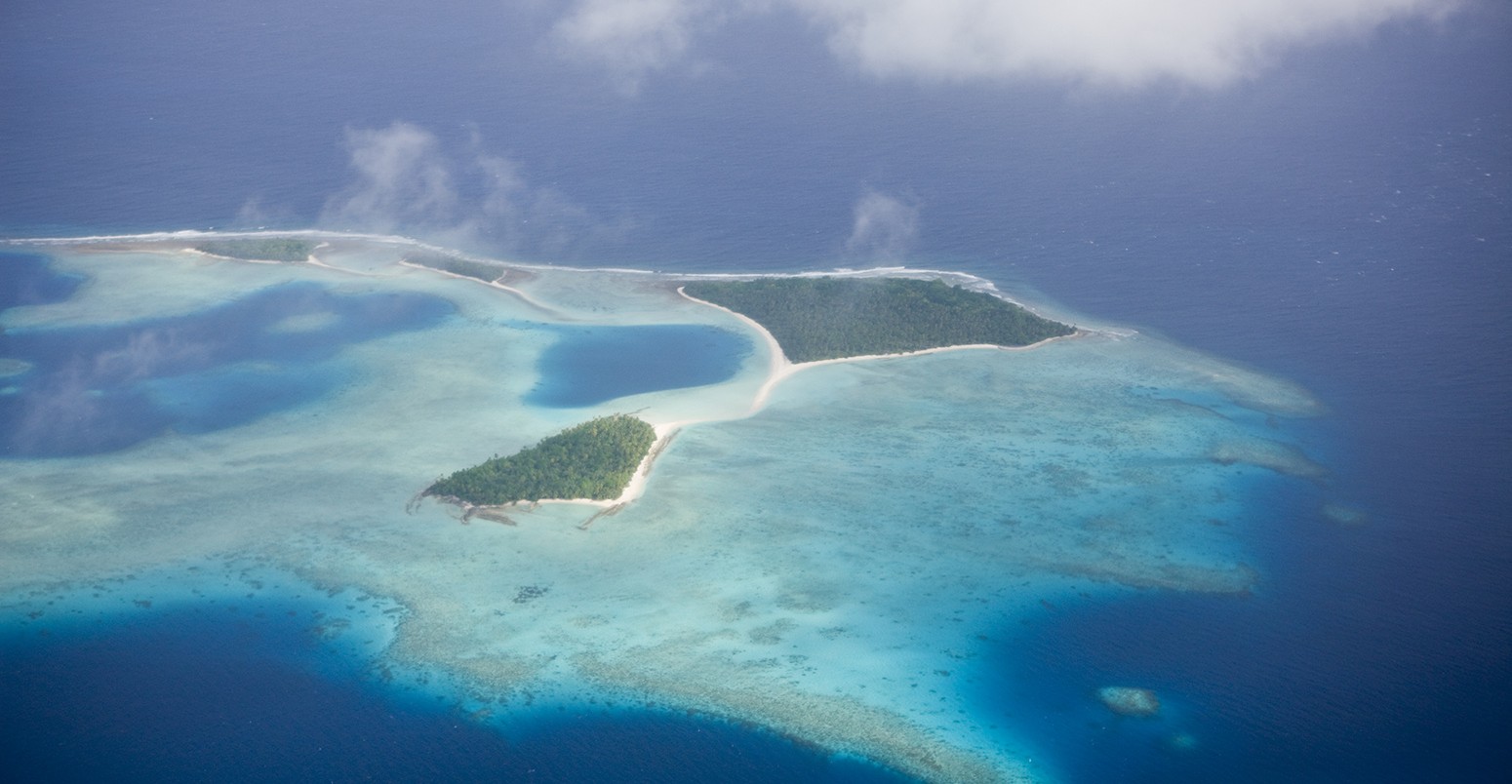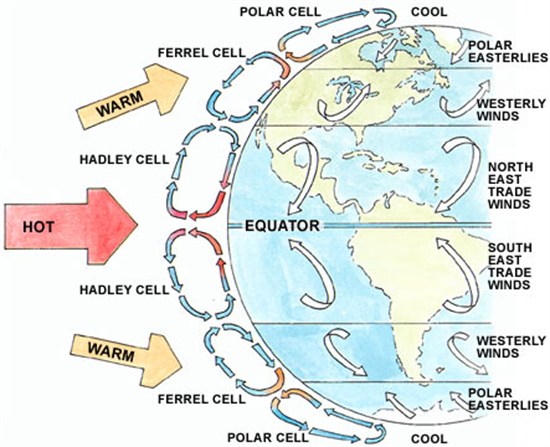
Pacific winds change the speed of global warming, says new study
Robert McSweeney
12.22.14Robert McSweeney
22.12.2014 | 4:00pmThe strength of the trade winds that cross the Pacific can affect how quickly the planet warns, new research suggests. By analysing the chemical makeup of corals in the tropical Pacific, researchers have found that changing wind patterns affected how quickly the Earth warmed during the last century.
The study adds “another piece of evidence” that strong Pacific winds are contributing to the recent slowdown in global surface temperature rise, says an accompanying News and Views.
Trade winds over the ocean
The trade winds are the typical east-to-west winds that blow across the tropics, which you can see in the diagram below. They are driven by warm air rising along the equator and the rotation of the Earth.
Circulation patterns in the Earth’s atmosphere. The trade winds are directly north and south of the equator, and blow east-to-west. Source: Greenfield Geography, Creative Commons 3.0
Another piece of research suggests that when the trade winds are strong they drive more heat into the deep Pacific ocean, which brings cooler water to the surface and has a cooling effect to global surface temperatures. Weaker winds have the opposite effect, transferring heat from the oceans to the atmosphere and causing surface temperatures to rise more quickly.
The new study, published in Nature Geoscience, uses samples from corals to piece together how wind patterns over the Pacific ocean have changed since the 1890s. The findings suggest that the strength of trade winds has influenced the rate of temperature rise in the 20th century.
The strength of the trade winds is caused in part by a natural climate phenomenon called the Interdecadal Pacific Oscillation (IPO). The IPO has positive and negative phases, which it switches between every few decades. When the IPO is negative, the winds tend to be stronger, and vice versa.
Measuring coral chemistry
Samples were taken from corals in the large lagoon off the tiny island of Tawara, part of Kiribati in the middle of the Pacific ocean.
Tawara shields the lagoon from trade winds blowing in from the east, leaving it calm. However, when the trade winds are weak, bursts of wind from the west can kick up sediment in the lagoon. This releases manganese into the water, which the corals then use to build their skeleton.
The corals form yearly growth bands, a lot like the rings of a tree, allowing scientists to study changes in the sediment available to them over time. Consider an analogy of a child building a castle from a pile of lego bricks, lead author Professor Diane Thompson tells us:
“Imagine that nearly all the bricks are red – that’s calcium – but every now and then there’s a blue brick – another element, say manganese. The kid isn’t paying very close attention to the colour, just building. So if someone comes and mixes in lots more blue blocks, the castle is going to become more blue. That’s like the coral – it just uses what’s at hand to make its skeleton.”
Rapid warming
The researchers created a record of wind pattern changes in the tropical Pacific from the corals. They found that wind changes could help explain how the rate of temperature rise varied through the twentieth century.
The coral record suggests, for example, that trade winds were weak between 1910 and 1940 when the Earth warmed by 0.4 degrees, and were strong from 1940 to 1970, during a period of relatively little increase in global temperatures. As Thompson puts it:
“Our coral sample shows that winds have influenced the rate of global temperature rise previously and in both directions: rapid warming occurs when trade winds are weak, and slower warming when trade winds are strong.”
Though trade winds weren’t alone in affecting the rate of warming through the last century, the study notes. Emissions of sunlight-reflecting aerosols from industry contributed to mid-century cooling, for example, and accumulating greenhouse gases from human activities became a dominant force in warming in later years.
‘A really important study’
The coral record the study produced is a significant discovery, co-author Professor Gerald Meehl tells us:
“[T]here are few observations from the tropical Pacific in the early twentieth century, so the coral record fills in an important gap.”
Professor Matthew England, an Oceanography Expert at the University of New South Wales, agrees:
“This is a really important study: it confirms the crucial role of the Pacific Ocean in driving decadal climate variability at a global scale.”
So what, if anything, does the research tell us about the current slowdown, or hiatus, in global surface temperature rise?
Since the turn of the century the Pacific trade winds have been very strong, Professor Thompson says, which means more heat is being pushed into the deep ocean, leaving less heat to warm the atmosphere. But this situation won’t last forever, she says:
“We also know that the Pacific flips and flops between states with weak and strong winds, so it’s just a matter of time before the winds weaken once again. Global warming will likely accelerate when Pacific trade winds weaken.”
Scientists can’t say exactly when this switch will happen, Thompson adds:
“We do know that the typical lifetime of a phase of this cycle is less than 30 years, and the current one began about 15 years ago. So although the timing of that switch remains difficult to anticipate, it would be most likely to happen within the next one to two decades.”
Despite trade winds affecting warming from one decade to the next, temperatures are still likely to rise substantially this century, Professor England adds:
“It’s important to note that the Pacific variability merely adds a modulation to the long-term trend of global warming, and that trend in global warming is going to continue in the long run unless greenhouse gas emissions are curbed.”
Main image: Aerial View of Marshall Islands, Ailinglaplap Atoll, Micronesia, Pacific Ocean. © Visuals Unlimited/Corbis.
Thompson, D. M. et al. (2014) Early twentieth-century warming linked to tropical Pacific wind strength, Nature Geoscience, doi:10.1038/ngeo2321 & Brönnimann, S. (2014) Pacemakers of warming, Nature Geoscience, doi:10.1038/ngeo2330


